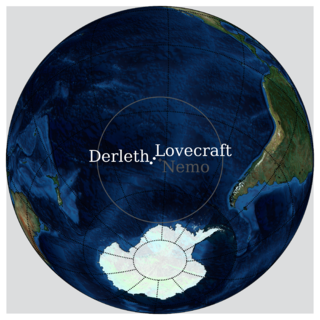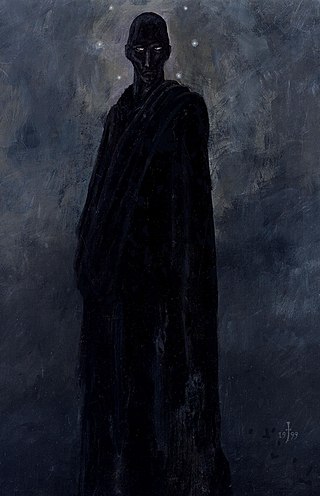
The Cthulhu Mythos is a mythopoeia and a shared fictional universe, originating in the works of American horror writer H. P. Lovecraft. The term was coined by August Derleth, a contemporary correspondent and protégé of Lovecraft, to identify the settings, tropes, and lore that were employed by Lovecraft and his literary successors. The name "Cthulhu" derives from the central creature in Lovecraft's seminal short story "The Call of Cthulhu", first published in the pulp magazine Weird Tales in 1928.

R'lyeh is a fictional lost city that was first mentioned in the H. P. Lovecraft short story "The Call of Cthulhu", first published in Weird Tales in February 1928. R'lyeh is a sunken city in the South Pacific and the prison of the entity called Cthulhu.

Cthulhu is a cosmic entity created by writer H. P. Lovecraft. It was introduced in his short story "The Call of Cthulhu", published by the American pulp magazine Weird Tales in 1928. Considered a Great Old One within the pantheon of Lovecraftian cosmic entities, this creature has since been featured in numerous popular culture references. Lovecraft depicts it as a gigantic entity worshipped by cultists, in the shape of a green octopus, dragon, and a caricature of human form. The Lovecraft-inspired universe, the Cthulhu Mythos, where it exists with its fellow entities, is named after it.

Shub-Niggurath is a deity created by H. P. Lovecraft. She is often associated with the phrase "The Black Goat of the Woods with a Thousand Young". The only other name by which Lovecraft referred to her was "Lord of the Wood" in his story The Whisperer in Darkness.

Nyarlathotep is a fictional character created by H. P. Lovecraft. The character is a malign deity in the Cthulhu Mythos, a shared universe. First appearing in Lovecraft's 1920 prose poem "Nyarlathotep", he was later mentioned in other works by Lovecraft and by other writers. Later, writers describe him as one of the Outer Gods, an alien pantheon.

Azathoth is a deity in the Cthulhu Mythos and Dream Cycle stories of writer H. P. Lovecraft and other authors. He is the supreme deity of the Cthulu Mythos and the ruler of the Outer Gods, and may also be seen as a symbol for primordial chaos, therefore being the most powerful entity in the entirety of the Cthulhu Mythos.

Hastur is an entity of the Cthulhu Mythos.

At the Mountains of Madness is a science fiction-horror novella by American author H. P. Lovecraft, written in February/March 1931. Rejected that year by Weird Tales editor Farnsworth Wright on the grounds of its length, it was originally serialized in the February, March, and April 1936 issues of Astounding Stories. It has been reproduced in numerous collections.

The Dream-Quest of Unknown Kadath is a novella by American writer H. P. Lovecraft. Begun probably in the autumn of 1926, the draft was completed on January 22, 1927 and it remained unrevised and unpublished in his lifetime. It is both the longest of the stories that make up his Dream Cycle and the longest Lovecraft work to feature protagonist Randolph Carter. Along with his 1927 novel The Case of Charles Dexter Ward, it can be considered one of the significant achievements of that period of Lovecraft's writing. The Dream-Quest combines elements of horror and fantasy into an epic tale that illustrates the scope and wonder of humankind's ability to dream.

"The Nameless City" is a short horror story written by American writer H. P. Lovecraft in January 1921 and first published in the November 1921 issue of the amateur press journal The Wolverine. It is often considered the first story set in the Cthulhu Mythos world. In the story, the protagonist travels to the middle of the Arabian Desert to explore an ancient underground city.
The Xothic legend cycle is a series of short stories by American writer Lin Carter that are based on the Cthulhu Mythos of H. P. Lovecraft, primarily on Lovecraft's stories "The Call of Cthulhu" and "Out of the Aeons".

The Whisperer in Darkness is a 26,000-word novella by American writer H. P. Lovecraft. Written February–September 1930, it was first published in Weird Tales, August 1931. Similar to The Colour Out of Space (1927), it is a blend of horror and science fiction. Although it makes numerous references to the Cthulhu Mythos, the story is not a central part of the mythos, but reflects a shift in Lovecraft's writing at this time towards science fiction. The story also introduces the Mi-Go, an extraterrestrial race of fungoid creatures.

"The Rats in the Walls" is a short story by American author H. P. Lovecraft. Written in August–September 1923, it was first published in Weird Tales, March 1924.

"The Thing on the Doorstep" is a horror short story by American writer H. P. Lovecraft, part of the Cthulhu Mythos universe. It was written in August 1933 and first published in the January 1937 issue of Weird Tales.

"Azathoth" is the beginning of an incomplete novel written by American horror fiction writer H. P. Lovecraft. It was written in June 1922, and published as a fragment in the journal Leaves in 1938, after Lovecraft's death. It is the first piece of fiction to mention the fictional being Azathoth, one of the major entities in Lovecraft's Cthulhu Mythos, though the entity only appears in the title.
Peter H. Cannon is an H. P. Lovecraft scholar and an author of Cthulhu Mythos fiction. Cannon works as an editor for Publishers Weekly, specializing in thrillers and mystery. He lives in New York City and is married with three children.
A Cthulhu Mythos anthology is a type of short story collection that contains stories written in, or related to, the Cthulhu Mythos genre of horror fiction launched by H. P. Lovecraft. Such anthologies have helped to define and popularize the genre.

The Xothic Legend Cycle: The Complete Mythos Fiction of Lin Carter is a collection of horror short stories by science fiction and fantasy author Lin Carter, edited by Robert M. Price. It gathers together his "Xothic" tales and some of his other Cthulhu Mythos writings. It was first published as a trade paperback by Chaosium in 1997 as book 13 of the publisher's "Cthulhu Cycle" series. The collection has also been translated into German.

Move Under Ground is a horror novel mashup by American writer Nick Mamatas, which combines the Beat style of Jack Kerouac with the cosmic horror of H. P. Lovecraft's Cthulhu Mythos. It is available as a free download via a Creative Commons license, CC BY-NC-ND 2.5 according to the License information in the CC version of the book.
American author H. P. Lovecraft (1890–1937) created a number of fictional deities throughout the course of his literary career. These entities are usually depicted as immensely powerful and utterly indifferent to humans, who can barely begin to comprehend them; however, some entities are worshipped by humans. These deities include the "Great Old Ones" and extraterrestrials, such as the "Elder Things", with sporadic references to other miscellaneous deities. The "Elder Gods" are a later creation of other prolific writers who expanded on Lovecraft's concepts, such as August Derleth, who was credited with formalizing the Cthulhu Mythos. Most of these deities were Lovecraft's original creations, but he also adapted words or concepts from earlier writers such as Ambrose Bierce, and later writers in turn used Lovecraft's concepts and expanded his fictional universe.















